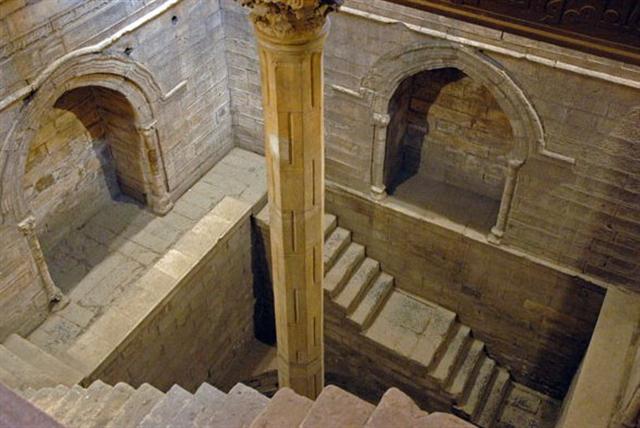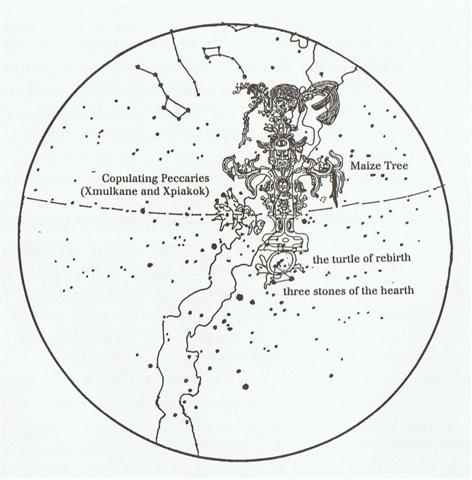Once again. From the central figure with a great droplet on his chest (tagata honui) in Ca1-6 to glyph 384 (= 13 * 29Ĺ + Ĺ) the distance was 378 nights, and this certainly indicated the synodic cycle of Saturn:
Curiously Saturn was on Hawaii also indicated as a planet which was moving swiftly - hardly understandable for modern astronomers, because Saturn is moving slowest of all of those mentioned in the week (Mercury, Venus, Mars, Jupiter, and Saturn). On the other hand, if we should consider for instance Tigris - in contrast to the peacefully moving Euphrat (who was carrying sweet water) - we would conclude that water indeed can be running quickly downwards. ... The season of year for this royal ballet was the same as that proper to a coronation; the first five days of the first month of the 'Season of Coming Forth', when the hillocks and fields, following the inundation of the Nile, were again emerging from the waters. For the seasonal cycle, throughout the ancient world, was the foremost sign of rebirth following death, and in Egypt the chronometer of this cycle was the annual flooding of the Nile ...
... 'I have run', he cries, 'holding the Secret of the Two Partners, the Will that my father has given me before Geb. I have passed through the land and touched the four sides of it. I traverse it as I desire.' ...
Significantly there are small tadpoles (Gardiner's I8) depicted under the date branches held in the palms of the God of Eternity, and they surely were intended to indicate where Land again was beginning to rise from the inundation. Experience tells us that after much rain frogs (I7) suddenly will become visible.
Furthermore, under the wrists of Heh we can see a panel where the Sun was not only sending his rays upwards (in form similar to the rongorongo henua type of glyph) but also what appears to be rain water pouring downwards. Although the basic type is listed as Gardiner's number F31, where chapter F refers to parts of mammals.
The Dogon people are said to have migrated from the region of ancient Egypt and we can find a clue in the words of OgotemmÍli: '... The life-force of the earth is water. God moulded the earth with water. Blood too he made out of water. Even in a stone there is this force, for there is moisture in everything. But if Nummo is water, it also produces copper. When the sky is overcast, the sun's rays may be seen materializing on the misty horizon. These rays, excreted by the spirits, are of copper and are light. They are water too, because they uphold the earth's moisture as it rises. The Pair excrete light, because they are also light ... 'The sun's rays,' he went on, 'are fire and the Nummo's excrement. It is the rays which give the sun its strength. It is the Nummo who gives life to this star, for the sun is in some sort a star.' It was difficult to get him to explain what he meant by this obscure statement. The Nazarene made more than one fruitless effort to understand this part of the cosmogony; he could not discover any chink or crack through which to apprehend its meaning. He was moreover confronted with identifications which no European, that is, no average rational European, could admit. He felt himself humiliated, though not disagreeably so, at finding that his informant regarded fire and water as complementary, and not as opposites. The rays of light and heat draw the water up, and also cause it to descend again in the form of rain. That is all to the good. The movement created by this coming and going is a good thing. By means of the rays the Nummo draws out, and gives back the life-force. This movement indeed makes life ... The intention was hardly to depict blood from a mammal but rather the blood pulsating forth from the wrists of the God of Eternity (Heh). This is not Gardiner's F31 but a broader flow, a flow from the Sun rather than from a mammal beast. We can also see a double set of 2 + 1 = 3 'buns' which perhaps inspired the design at nakshatra Heze:
According to Wilkinson they are buns. Together with the pulsating flow of blood we can imagine a precursor to the idea of bread and wine, the essential food for Mediterranean man, and possibly also for Mesopotamian man. But in South America the important bread came from maize, from the Maize God:
Towards the end of the year the turtle month was followed by the month of maize (kan):
|
|||||||||||||||||||||||||||||||||||||||||||||||||||||||||||||||||||||||||||||||||||||||||||||||||||||||||||||












